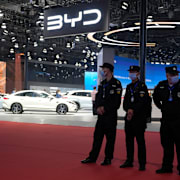
Bilen blir batteriet i ny konceptbil
I stället för de litiumjon-batterier som i dag används i elbilar vill italienska Lamborghini använda så kallade superkondensatorer i en ny konceptbil som utvecklas tillsammans med forskare vid amerikanska MIT, skriver Bloomberg. Superkondensatorer kan släppa ifrån sig stora mängder energi på kort tid – passande för en superbil – men har samtidigt en jämförelsevis låg energitäthet vilket kräver ett jättebatteri. Lamborghinis lösning är att själva bilen blir batteriet – superkondensatorerna byggs in i karossen som ska göras i kolfiber.
– Om Lamborghini och vi kan leverera på det här löftet tror jag att det blir väldigt coolt för framtiden för all transport, säger Mircea Dinca vid MIT till Bloomberg.
bakgrund
Superkondensatorer
Wikipedia (en)
A supercapacitor (SC) (also electric double-layer capacitor (EDLC), also called supercap, ultracapacitor or Goldcap) is a high-capacity capacitor with capacitance values much higher than other capacitors (but lower voltage limits) that bridge the gap between electrolytic capacitors and rechargeable batteries. They typically store 10 to 100 times more energy per unit volume or mass than electrolytic capacitors, can accept and deliver charge much faster than batteries, and tolerate many more charge and discharge cycles than rechargeable batteries.
Supercapacitors are used in applications requiring many rapid charge/discharge cycles rather than long term compact energy storage: within cars, buses, trains, cranes and elevators, where they are used for regenerative braking, short-term energy storage or burst-mode power delivery. Smaller units are used as memory backup for static random-access memory (SRAM).
Unlike ordinary capacitors, supercapacitors do not use the conventional solid dielectric, but rather, they use electrostatic double-layer capacitance and electrochemical pseudocapacitance, both of which contribute to the total capacitance of the capacitor, with a few differences:
Electrostatic double-layer capacitors use carbon electrodes or derivatives with much higher electrostatic double-layer capacitance than electrochemical pseudocapacitance, achieving separation of charge in a Helmholtz double layer at the interface between the surface of a conductive electrode and an electrolyte. The separation of charge is of the order of a few ångströms (0.3–0.8 nm), much smaller than in a conventional capacitor.
Electrochemical pseudocapacitors use metal oxide or conducting polymer electrodes with a high amount of electrochemical pseudocapacitance additional to the double-layer capacitance. Pseudocapacitance is achieved by Faradaic electron charge-transfer with redox reactions, intercalation or electrosorption.
Hybrid capacitors, such as the lithium-ion capacitor, use electrodes with differing characteristics: one exhibiting mostly electrostatic capacitance and the other mostly electrochemical capacitance.
The electrolyte forms an ionic conductive connection between the two electrodes which distinguishes them from conventional electrolytic capacitors where a dielectric layer always exists, and the so-called electrolyte (e.g. MnO2 or conducting polymer) is in fact part of the second electrode (the cathode, or more correctly the positive electrode). Supercapacitors are polarized by design with asymmetric electrodes, or, for symmetric electrodes, by a potential applied during manufacture.
Omni är politiskt obundna och oberoende. Vi strävar efter att ge fler perspektiv på nyheterna. Har du frågor eller synpunkter kring vår rapportering? Kontakta redaktionen



